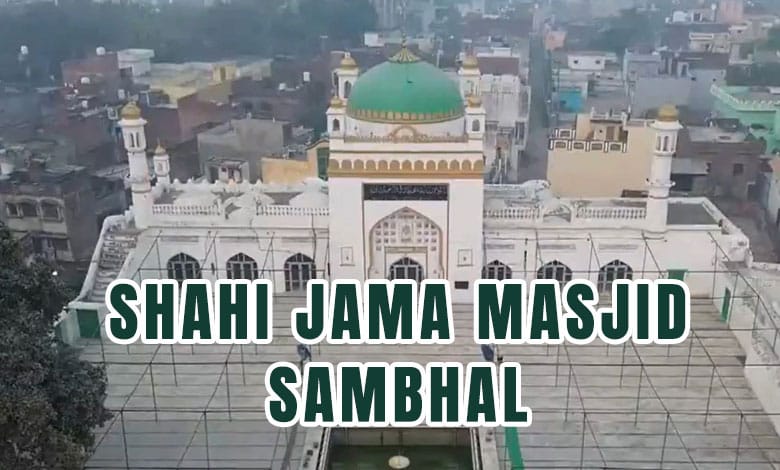Was Sambhal’s Shahi Jama Masjid Built Over a Kalki Temple? Insights from the 1879 ASI Report and Historical Claims
The ongoing violence in Sambhal, sparked by a court-mandated survey of the Shahi Jama Masjid, has deepened a centuries-old dispute over the mosque's origins.

Sambhal, Uttar Pradesh: The ongoing violence in Sambhal, sparked by a court-mandated survey of the Shahi Jama Masjid, has deepened a centuries-old dispute over the mosque’s origins. As clashes continue, experts and historians are offering new insights that challenge the claims of the mosque being built over the ruins of a centuries-old Kalki temple.
The unrest erupted after a seven-member survey team entered the Shahi Jama Masjid to conduct a survey, as mandated by a local court following a petition that alleged the mosque was constructed over the remains of an ancient Shri Hari Har Temple. The Hindu side claims that the mosque was built after Mughal Emperor Babur destroyed the temple in 1526, a claim that has stirred religious sentiments and political controversy in the region.
However, historians and archaeological experts argue that there is no definitive evidence to support the theory that the mosque was built atop a Hindu temple dedicated to Lord Vishnu’s prophesied 10th incarnation, Kalki. According to an 1879 Archaeological Survey of India (ASI) report by British archaeologist ACL Carlleyle, the mosque’s construction materials do not definitively point to the destruction of a temple. Carlleyle observed that the mosque was primarily built with rubble-masonry, a common construction technique that reuses stones from older structures. However, this does not conclusively establish that the Shahi Jama Masjid stands on the ruins of a Hindu temple.
Carlleyle’s findings suggest that while parts of the mosque may have been built using stone from older structures, this does not prove that it was a temple that was demolished to make way for the mosque. “The evidence of rubble-masonry simply indicates the reuse of materials, which was a common practice during that era,” Carlleyle wrote in his report. “It is highly speculative to claim that this was done on the site of a temple.”
Historians like Meenakshi Jain and Sri Ram Sharma have pointed to similar cases of temples being demolished during Babur’s reign, but they do not definitively link the Shahi Jama Masjid with any particular Hindu temple. Jain, in her research, refers to Babur’s destruction of temples in other parts of India, including the famous destruction of a temple in Ayodhya. However, she acknowledges that there is insufficient evidence to confirm that a Kalki temple stood at the site of the Shahi Jama Masjid.
Additionally, the authenticity of an inscription often cited as evidence that Babur commissioned the mosque has been questioned. A report by the first Director-General of the ASI, Alexander Cunningham, addresses the doubts surrounding the inscription’s validity, suggesting that the inscription could indeed be genuine, but adding that local Hindu groups have disputed its authenticity, claiming it might have been forged.
Also Read: Arrest Warrant Issued for Gautam Adani in $265 Million Bribery Case: What Happens Next?
The controversy also comes in the wake of Prime Minister Narendra Modi’s recent inauguration of the Kalki Dham Mandir in Sambhal, located approximately 20 kilometers from the Shahi Jama Masjid. While the new Kalki temple has become a symbol of religious devotion for many Hindus, it also fuels the debate over the historical significance of the Shahi Jama Masjid.
While historians continue to investigate the matter, there is no clear evidence that the mosque was built directly over a Hindu temple, as some claim. The use of rubble-masonry in its construction, as documented by ASI, suggests that the Shahi Jama Masjid may have been built on an existing site that may have housed various structures over time, but not necessarily a Kalki temple.
As the violence in Sambhal subsides and a further investigation into the matter unfolds, the claim that the Shahi Jama Masjid was built over a temple remains speculative. The situation remains tense, with the district administration imposing restrictions, including school closures and a suspension of mobile internet, in a bid to prevent further violence.
The ongoing court-mandated survey is set to be completed by November 29, and the final report may offer further clarity on the historical claims surrounding the Shahi Jama Masjid. For now, experts urge caution and remind the public that historical disputes are complex, requiring careful examination of evidence before drawing conclusions.
While the Shahi Jama Masjid remains an important religious site for the Muslim community, the dispute over its origins continues to be a source of tension in the region. The violence of recent days highlights the deep emotional and political stakes in this long-standing issue, with each side asserting their version of history, yet lacking definitive evidence to support their claims. As Sambhal grapples with the aftermath of the riots, the question of whether the mosque was built over a temple remains an open and contentious issue.
